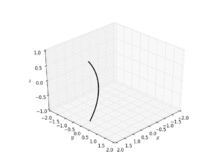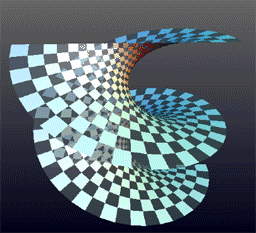

In geometry, a catenoid is a type of surface, arising by rotating a catenary curve about an axis (a surface of revolution).[1] It is a minimal surface, meaning that it occupies the least area when bounded by a closed space.[2] It was formally described in 1744 by the mathematician Leonhard Euler.
Soap film attached to twin circular rings will take the shape of a catenoid.[2] Because they are members of the same associate family of surfaces, a catenoid can be bent into a portion of a helicoid, and vice versa.
YouTube Encyclopedic
-
1/3Views:8424 1121 321 198
-
Catenoid
-
Collapsing Catenoids: Soap Bubbles and Surface Area Minimization
-
Minimal Surfaces—The Shapes That Help Us Understand Black Holes
Transcription
Geometry
The catenoid was the first non-trivial minimal surface in 3-dimensional Euclidean space to be discovered apart from the plane. The catenoid is obtained by rotating a catenary about its directrix.[2] It was found and proved to be minimal by Leonhard Euler in 1744.[3][4]
Early work on the subject was published also by Jean Baptiste Meusnier.[5][4]: 11106 There are only two minimal surfaces of revolution (surfaces of revolution which are also minimal surfaces): the plane and the catenoid.[6]
The catenoid may be defined by the following parametric equations:
In cylindrical coordinates:
A physical model of a catenoid can be formed by dipping two circular rings into a soap solution and slowly drawing the circles apart.
The catenoid may be also defined approximately by the stretched grid method as a facet 3D model.
Helicoid transformation

Because they are members of the same associate family of surfaces, one can bend a catenoid into a portion of a helicoid without stretching. In other words, one can make a (mostly) continuous and isometric deformation of a catenoid to a portion of the helicoid such that every member of the deformation family is minimal (having a mean curvature of zero). A parametrization of such a deformation is given by the system
- corresponds to a right-handed helicoid,
- corresponds to a catenoid, and
- corresponds to a left-handed helicoid.
References
- ^ Dierkes, Ulrich; Hildebrandt, Stefan; Sauvigny, Friedrich (2010). Minimal Surfaces. Springer Science & Business Media. p. 141. ISBN 9783642116988.
- ^ a b c Gullberg, Jan (1997). Mathematics: From the Birth of Numbers. W. W. Norton & Company. p. 538. ISBN 9780393040029.
- ^ Helveticae, Euler, Leonhard (1952) [reprint of 1744 edition]. Carathëodory Constantin (ed.). Methodus inveniendi lineas curvas: maximi minimive proprietate gaudentes sive solutio problematis isoperimetrici latissimo sensu accepti (in Latin). Springer Science & Business Media. ISBN 3-76431-424-9.
{{cite book}}: CS1 maint: multiple names: authors list (link) - ^ a b Colding, T. H.; Minicozzi, W. P. (17 July 2006). "Shapes of embedded minimal surfaces". Proceedings of the National Academy of Sciences. 103 (30): 11106–11111. Bibcode:2006PNAS..10311106C. doi:10.1073/pnas.0510379103. PMC 1544050. PMID 16847265.
- ^ Meusnier, J. B (1881). Mémoire sur la courbure des surfaces [Memory on the curvature of surfaces.] (PDF) (in French). Bruxelles: F. Hayez, Imprimeur De L'Acdemie Royale De Belgique. pp. 477–510. ISBN 9781147341744.
- ^ "Catenoid". Wolfram MathWorld. Retrieved 15 January 2017.
Further reading
- Krivoshapko, Sergey; Ivanov, V. N. (2015). "Minimal Surfaces". Encyclopedia of Analytical Surfaces. Springer. ISBN 9783319117737.
External links
- "Catenoid", Encyclopedia of Mathematics, EMS Press, 2001 [1994]
- Catenoid – WebGL model
- Euler's text describing the catenoid at Carnegie Mellon University
- Calculating the surface area of a Catenoid
- Minimal Surface of Revolution







![{\displaystyle (u,v)\in (-\pi ,\pi ]\times (-\infty ,\infty )}](https://wikimedia.org/api/rest_v1/media/math/render/svg/69bd6d31446bbbbdb601db5ced84afb267ec09fb)




